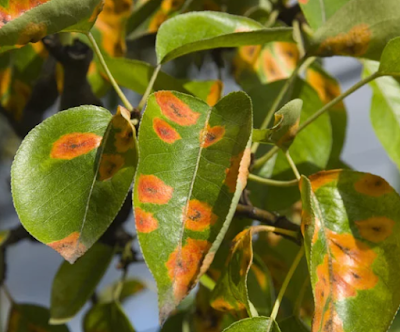 |
| Symptoms of plant diseases |
SYMPTOMS OF MAJOR PLANT DISEASES
Sheath blight of rice: Irregular purple brown spots with ashy w center forms on the leaf sheath which are looks like elliptical or oval shaped lesions (Cobra Snake like skin).
Blast of rice:Spindle shaped (eye shaped) spots where center is ashy with yellow halo on the leaf blade.
BLB of rice: The margin of the leaves becomes blighted with wavy lesions which start from minute spots on the tip or edge of leaf (Puckering symptom).
Bakane of rice:Elongated inter-node with narrow foot region. Advantageous root develops on the lower nodes of plants.
Tungro of rice:Stunted growth, less number of tillers, young leaves are twisted and orange yellow colored.
Ufra: Flag leaf sheath become swollen, twisted and form a boat like structure which enclose the panicle.
Black point of wheat:The embryo of wheat become darken, black and seed shriveled.
Rust of wheat:Reddish brown pustules of rust found on the leaf, leaf sheath and stem.
Loss smut of wheat:The spores in young spikelets become covered by a silvery membrane which burst and only the empty rachis found on the field.
Stem rot of jute:Numerous black dots on the stem, the black lesion become necrotic and enlarge to girdle the stem.
Black band of jute:A dense black band develops around the stem at about 2-3 ft above the ground level. The infected plant has no leaves.
Anthracnose of jute:Several dark brown spots coalesce and produce large cankerous lesion. The fiber of the jute may crack and exposed.
Red rot of sugarcane:In the field, splited cane may found. Or if the cane cut longitudinally the characteristic patches of red and white color is found on internal tissues.
Tikka of groundnut:Brown to black (1-10) mm sized spot found on peanut leaves. Early leaf spot with yellow halo formed on upper leaf surface but late leaf spot without yellow halo formed on lower leaf surface.
Grey leaf spot of mustard: Small, dark colored spots is formed on leaf which rapidly form circular, concentric ring like lesions upto 1 cm in diameter. Several spots coalesce together and show blighting symptom.
Foot and root rot of lentil: Yellowing of leaves. If the infected seedlings are uprooted, reddish dark discoloration found on the root. No or less presence of rootlets on root.
Wilt of pulses: Gradual yellowing, withering and drying of leaves followed by drying of entire plant or some of it’s branches. Patches of disease plants are scattered throughout the field.
Cercospora leaf spot of mungbean: Angular reddish spots with grey centers and purplish borders are developed on the leaf surface. In severe case, the affected tissue is killed and dead portion drops out.
Mosaic of bean:Yellow and green patches are present all over the leaves scatteredly. Infected plants become stunted and dwarf.
Black arm of cotton:Angular, water soaked brown to black lesions appear on the leaf. Brown to black sunken lesions appear at the stem. Spots are also seen on the ball and rapidly ball turn into black.
Late blight of potato: Initially water soaked spots produce on the leaflets which gradually turn brown. The spots increase rapidly to produce general blighting symptom. Finally entire crown may fall over in a rotten pulp.
Scab of potato:The skin of the potato become rough, irregular, corky and slightly raised.
Soft rot of potato:The potato became soft and rotten. If the rot portion is pressed with finger the watery tissue come out from it with bad odor.
Fruit rot of brinjal:In nursery bed damping off symptoms develops on seedling. The fruit become rotten, mummified, many dot picnidia develop on the fruit surface.
Root knot of brinjal:The normal root contains a lot of gall or knot. The number of secondary rootlets are reduced.
Damping off of seedling: The plumule and or the radical of germinated seedling become rotten and the seedling looks droopy. Brown decay happen on the collar region extending upward and downward.
Anthracnose of mango:Black, sunken spots develop on fruit surface and cracking may occur. The typical anthracnose symptom is “tear staining”.
Stem-end rot of mango: Epicarp of the stem end show purple black discoloration which enlarge and whole fruit become soft and rotten.
Sigatoka of banana:Spindle shaped dark brown lesions with yellow halo formed on the margin of leaf blade which is parallel to vein. Some lesions coalesce together and dry up which extend from edge to center.
Panama of banana:Sudden wilting of older plant or individual leaf. Leaves turn yellow and leaf blade hangs down. Pseudo-stem may split longitudinally. Excessive sucker production occur. Discoloration may seen on vascular region of pseudo-stem.
Bunchy top of banana: Short, narrow and chlorotic leaves, margin of leaves rolled upward and several leaves arise in cluster giving a rosette structure.
Dieback of citrus:Terminal leaves fall off and shoots are dried from the tip towards back. Dried branches are straw and ash colored.
Scab of citrus:Irregular, wrinkled, warty lesions are formed on the leaves and fruit skin. Damaged fruit become unattractive and drop off from the tree.
Gummosis of citrus:Profuse gummy exudates come out from the foot region bark. The raised lesion spread vertically more than laterally.
Bud rot of coconut:The bud falls prematurely which black watery and rotten mass is come out from the base of bud if pressed with finger. Foul smell come out from the rotten area of bud.
Frog eye leaf spot of tobacco: Mainly occurs on mature and lower leaves. The spots are brown with ash or grey center surrounded by black margin which looks like the eye of frog.
Milder blight of tea:Pink to radish round spot develops on the young leaves. Spots are concave on the upper surface and convex on the lower surface of leaves which looks like blister.